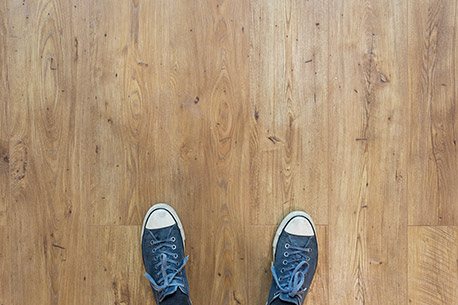
30 Mar When to repair and when to replace
The fact is, floors are not indestructible and they won’t last forever. Steps and measures can be taken to prolong the life of your flooring, but eventually, it will need replacing. To save you time and money, we explain the tell-tale signs which will let you know if your flooring requires a repair or a replacement for the most common floor types.
Safety flooring
If you have safety flooring and it appears worn and in need of a repair, this should be an instant replacement. It is vital to keep these types of floorings spick and span to comply with specific guidelines and requirements. Areas like swimming baths, restaurant kitchens and hospitals all rely upon the safety of their floors. If they lose their slip resistance, ease of cleaning or water resistance levels, they pose a risk and must be replaced instantly.
Tile flooring
There are multiple signs that a tile floor needs repairing. The largest one is its age. Being one of the most durable and long lasting, your tile floor shouldn’t need replacing for almost an entire lifetime. Whether it’s ceramic, marble or granite, tiles are strong enough to last for anything from 75 to 100 years. If you notice a crack or a stain on part of your flooring, due to it being made up of a selection of separate square tiles, you are easily able to repair a small section of your flooring. Buying additional tiles in bulk could be a good idea. If you make repairs to your tile flooring over the years and then find that your tile is no longer in production, you will need to replace the entire floor with a new tile. That is, of course, only if you don’t fancy the ‘one odd tile’ look!
Although cracks are common on tile floorings from heavy items such as fridge freezers or washing machines, if you notice that they appear for no apparent reason, or the tiles begin to lift and loosen, it may be due to an issue with the foundations. This would call for a replacement. Although they have the capability to withstand around 100 years, natural instances can occur to cause a need for replacing.
Carpet flooring
The life span of carpet flooring can vary due to many factors, such as the amount of people walking and wearing it down daily, and the quality of the fibres which make up the carpet. Lower quality carpets will therefore wear out before one made of a higher quality would. Typically, carpets can last anything from 5 – 25 years.
Damage such as staining and matting can be repaired, and it will be down to you as to when you feel the issue has gotten to a point of needing a full carpet replacement. When a carpet starts to show tears and fraying, it will be harder to repair it and you will save time and effort, as well as preventing the issue from reoccurring on separate occasions, by replacing your carpet.
Odours and pet hairs can also find ways of embedding themselves into your carpet. If you suffer with allergies and the person who lived in your home before you owned a pet, no amount of hoovering or washing will remove the hair from within the carpet. In instances like this, it is most effective to take the carpet up and replace it. Odours work in the same way. Simple things like spilling foods or drink, or even just the age of your carpet, can leave an odour that just won’t shift unless replaced completely.
Laminate flooring
More common than not, replacing your laminate flooring is the simpler option. Repairs are possible but not always permanent. If the corner of your laminate flooring begins to peel or lift up, or if stains appear, it Is most likely down to excess heat, water spillage and leakage, or its age. Replacing the whole floor is often the best way to repair this. However, if you look after your laminate flooring, it should last up to 15 – 25 years.
Wooden flooring
Wooden flooring can easily last up to 25 years, so long as you treat it and use the appropriate care. When damage appears, it may be that you can simply treat the floor to erase or hide the marks, rather than repair that section of flooring. Options such as sanding, oiling or varnishing will all help to erase damaged areas and bring the floor to life once again.
The issue with wooden flooring is when the creaking begins. This seems to send a ripple affect across your room, allowing the majority of the other floorboards to join in the harmony of creaking and squeaking. At this point, your only option would be a replacement. It is also an idea to keep an eye out for sloping or dipping floorboards as this may indicate that the foundations of your home are moving. A flooring repair or replacement should not be carried out until a professional has assessed the foundations.
If you are looking for advice on whether your flooring needs a repair or a replacement, give our expert team at Easifit Flooring a call on 0800 096 1171 or drop us an email at .
March 30, 2020

































